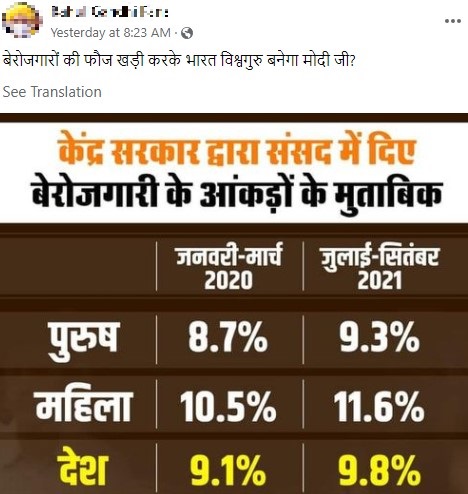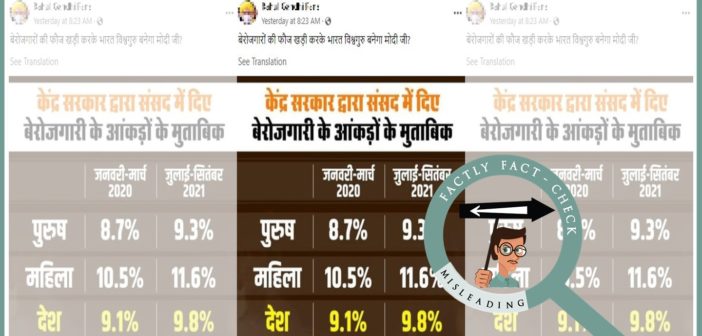A post claiming to show the unemployment rates for Jan-Mar 2020 and July-Sept 2021 and comparing them to show the dismal performance of the Narendra Modi government, is being widely shared on social media. Let us fact-check the claim made in the post.

Claim: Unemployment data for Jan-Mar 2020 is compared with the unemployment rates of July-Sept 2021.
Fact: Though the data provided in the post is true to an extent, the comparison is not appropriate. The data for the quarter Jan-Mar 2020 (the quarter before the COVID-19 lockdown) is compared to the July-Sept 2021 quarter, which is after the initial lockdown. According to Periodic Labour Force Surveys, the unemployment rate registered a decline from 13.2% in July-Sept 2020 quarter to 9.8% in July-Sept 2021. The male unemployment rate declined from 12.6% to 9.3% and the female unemployment rate declined from 15.8% to 11.6%. The unemployment rate registered a decline from 6.1% in 2017-18 to 4.8% in 2019-20. The male unemployment rate declined from 6.2% to 5.1% and the female unemployment rate declined from 5.7% to 4.2% in those years. Hence, the claim made in the post is MISLEADING.
The National Statistical Office (NSO), Ministry of Statistics and Programme Implementation, has been conducting Periodic Labour Force Survey (PLFS) since 2017. This survey measures the unemployment situation annually for both rural & urban areas and quarterly for urban areas only.
The Unemployment rate is defined as the percentage of unemployed persons in the labour force. The unemployment rate is calculated based on two approaches, namely the usual status (ps+ss) approach and the current weekly status approach (CWS). We have considered the usual status approach while considering the data in this article. According to an earlier Factly article on the PLFS 2019-20 report, in terms of the CWS approach, the unemployment rate remained almost the same in those three years.
Though the data provided in the post is true to an extent, the comparison done is not appropriate. The data for the quarter Jan-Mar 2020 (the quarter before the COVID-19 lockdown) is compared to the July-Sept 2021 quarter, which is after the initial lockdown.
The unemployment rate registered a decline from 13.2% in July-Sept 2020 quarter to 9.8% in July-Sept 2021. The male unemployment rate declined from 12.6% to 9.3% and the female unemployment rate declined from 15.8% to 11.6%.
Recently, the yearly data of PLFS has also been released. The PLFS data taken here is that of the combination of rural and urban unemployment data.
The unemployment rate registered a decline from 6.1% in 2017-18 to 4.8% in 2019-20. The male unemployment rate declined from 6.2% to 5.1% and the female unemployment rate declined from 5.7% to 4.2% in the last few years.
The quarterly bulletins of PLFS were also released. The press notes for the relevant quarters can be seen here, here, and here. The initial lockdown in 2020 and the second wave of COVID-19 have impacted the quarterly numbers i.e., unemployment rates. The unemployment rates were high during these periods.
To sum it up, this comparison of unemployment rates before, and after the pandemic-induced lockdowns is misleading.



